Easy Yoghurt Flatbread (No Yeast)
This easy yoghurt flatbread recipe uses only a few simple ingredients, and you can whip the flatbreads up in no time. Serve it with comforting soups and stews, spread it with hummus or labneh for a snack, or turn them into flatbread pizzas.
This no-yeast yoghurt flatbread recipe is an easy midweek staple. I adore yeasted bread, but the convenience of this oh-so-easy-to-make quick flatbread recipe is such a perk.
Whenever I have only a few odds and ends in the fridge, I turn to homemade flatbread for an easy dinner. They are a superb vehicle for leftovers. And you can even grill them in the oven with cheese for super quick flatbread pizzas.
The first yoghurt flatbread recipe I tried was Anna Jones’s recipe from The Modern Cook’s Year. Over time, her recipe evolved to suit my favourite yoghurt and preferred flour. And you can do the same.
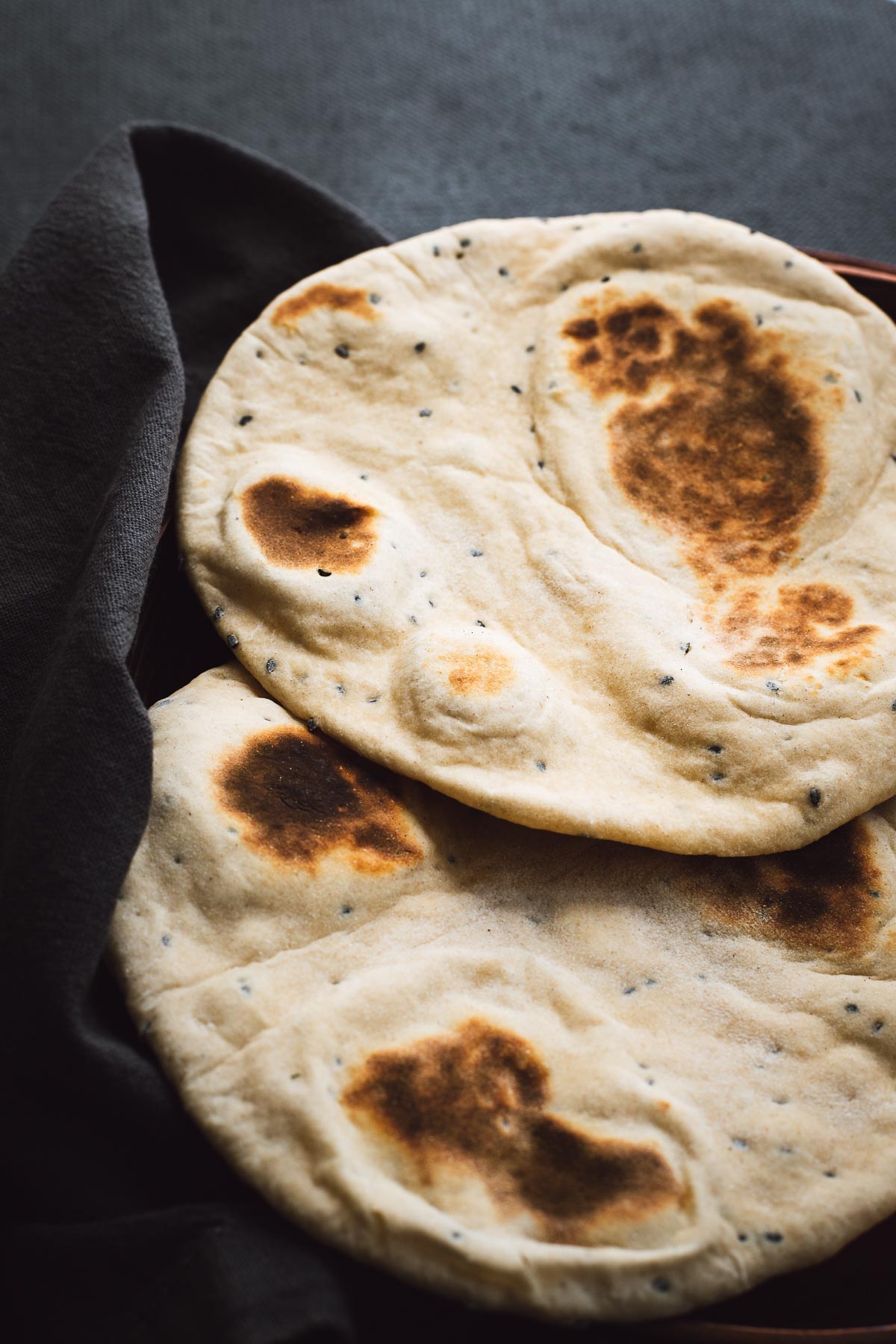
Ingredients & substitutes
This easy flatbread recipe relies on only a handful of simple ingredients. And the recipe is very forgiving, so use what you have around the house.
- Flour: I use plain all-purpose white flour, cake flour, or even white bread flour. You can also use spelt flour or a mix of whole wheat and plain flour. If you prefer self-raising flour, just omit the baking powder.
- Baking powder: Leave the baking powder if you have self-raising flour. You can also swap the teaspoon and a half of baking powder for a scant teaspoon of baking soda (bicarbonate of soda).
- Salt: I use dessert salt, but you can use kosher salt or sea salt.
- Nigella seeds: This is a completely optional add-in, but I love the earthy flavour and the pretty black specks of Nigella seeds in the finished flatbread. Try a teaspoon of cumin, caraway or fennel seeds instead.
- Yoghurt: I use full-fat plain Greek yoghurt, but you can use any plain yoghurt. If your natural yoghurt is thin, you can add a tablespoon of olive oil to add some fat if you want.
How to make yoghurt flatbread (step-by-step)
This yeast-free flatbread recipe is super quick, easy and super straightforward, but it always pays to be organised. So, gather your ingredients, a mixing bowl, a rolling pin and a damp kitchen towel.
You can make homemade yoghurt flatbread in four easy steps in 30 minutes:
- Step 1: Mix the dry ingredients
- Step 2: From the dough
- Step 3: Let the dough rest for 15 minutes
- Step 4: Roll the dough portions into disks
- Step 5: Cook in a hot skillet for three to four minutes each
Step 1: Mix the dry ingredients
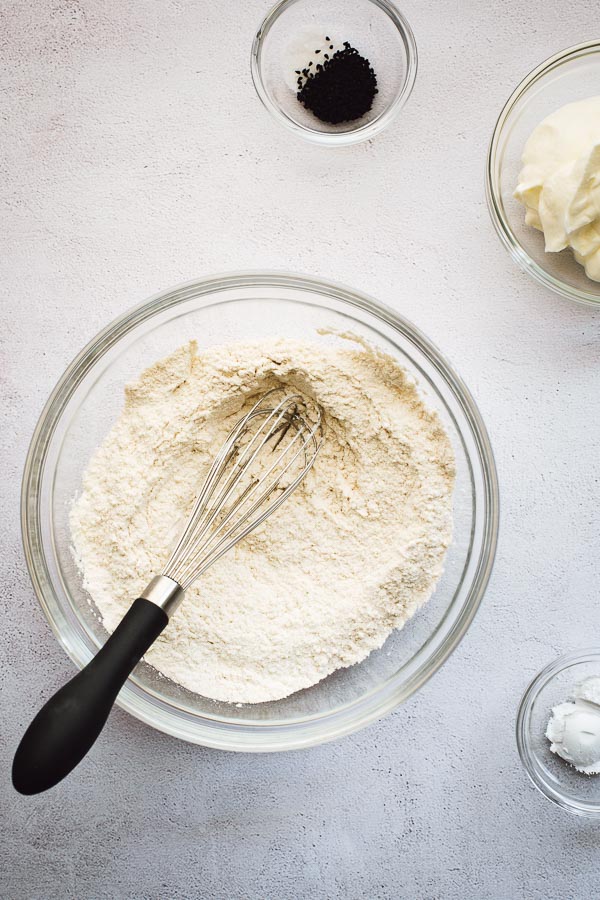
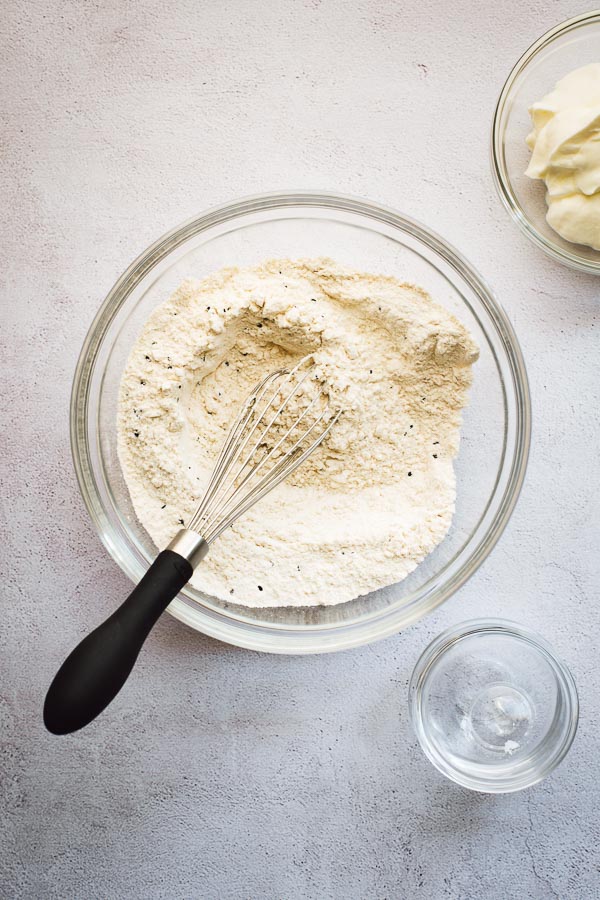
Mix the dry ingredients in a medium-sized bowl – reserving two tablespoons of flour. I love the flatbreads flecked with tiny black nigella seeds. But you can also use cumin or caraway seeds or omit the seeds entirely.
Step 2: Form the dough
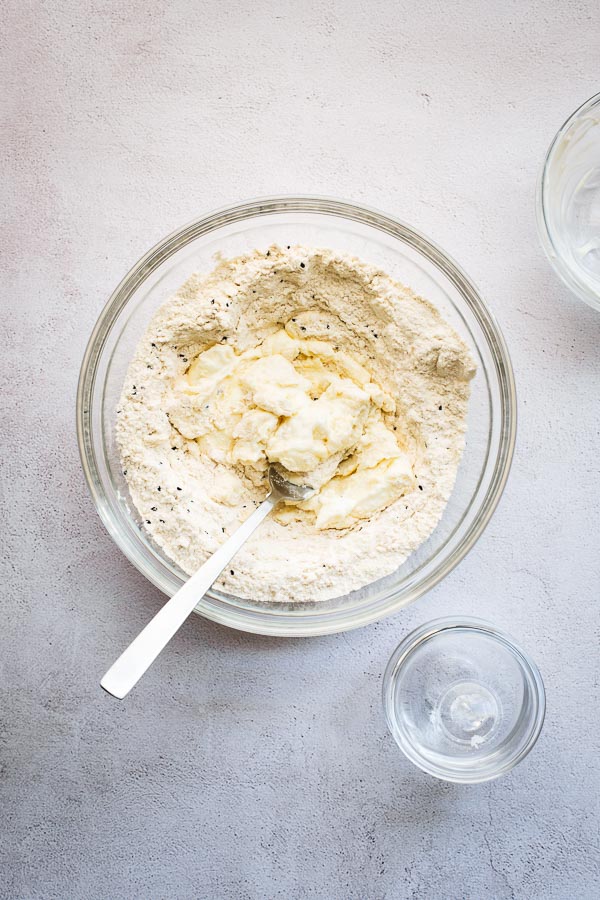
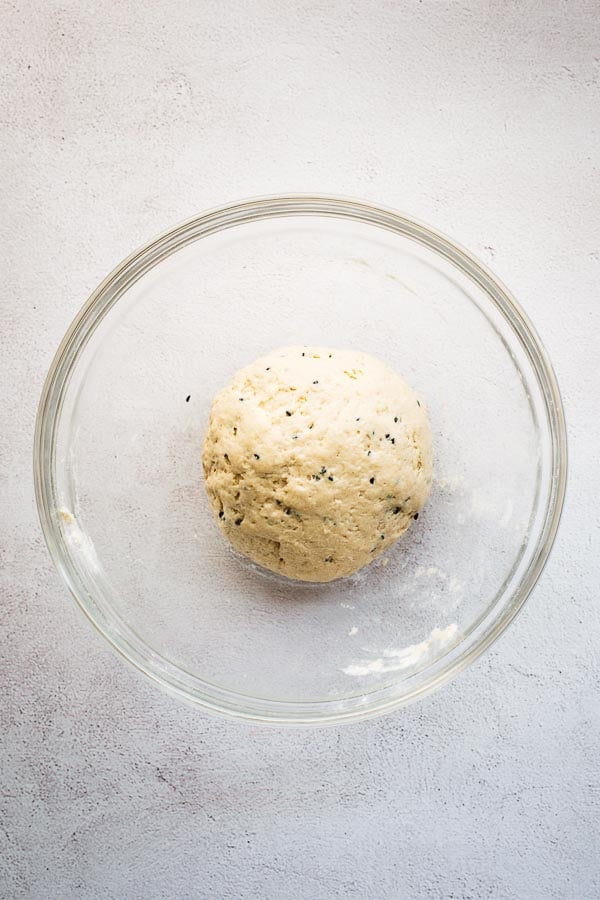
Add Greek-style or plain yoghurt to the dry ingredients. And bring the dough together. First, stir everything with a fork or wooden spoon, then jump in with your hands.
If the dough is visibly dry and struggling to come together, add a splash of water. Similarly, if the dough is too wet, add the reserved flour – one tablespoon at a time – until you have a dough that comes together and does not stick to your hands too much. A little stickiness is fine.
If you don’t mind the extra equipment to wash up, you can also use a stand mixer or food processor to prepare the dough.
Once mixed, give the dough a quick knead on a clean work surface to form a smooth ball – only for a minute or so. The dough won’t be as elastic as bread dough. And if it sticks too much while kneading, sprinkle it with flour.
Step 3: Rest the dough for 15 minutes
Place the dough back in the mixing bowl and cover it with a damp tea towel. Rest the dough for 15 minutes. Don’t skip this step, or the flatbread will tear as it puffs up in the pan.
Heat your dry frying pan over medium-high heat. I use a cast iron skillet, but any non-stick pan will work well. You can turn it down to medium heat once hot.
Step 4: Roll out the flatbreads
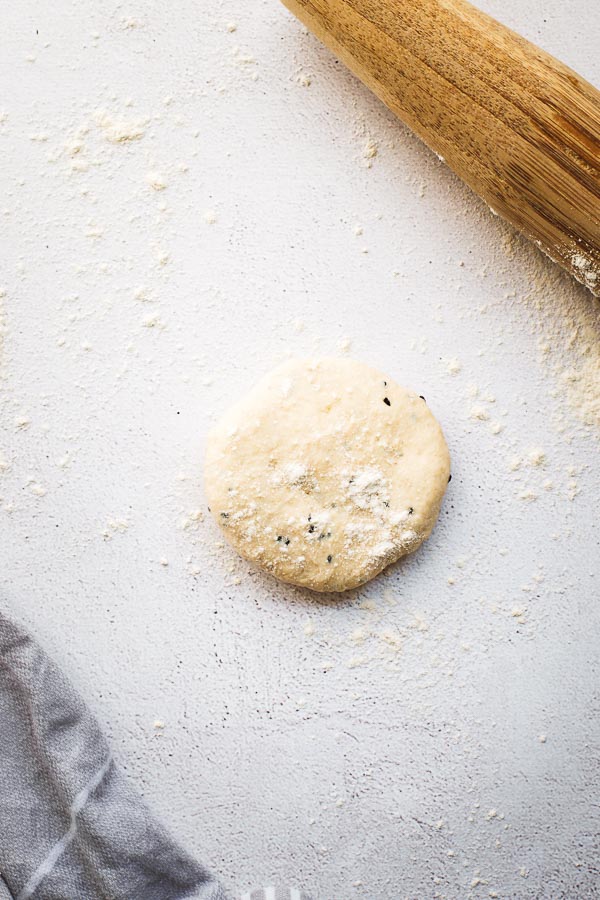
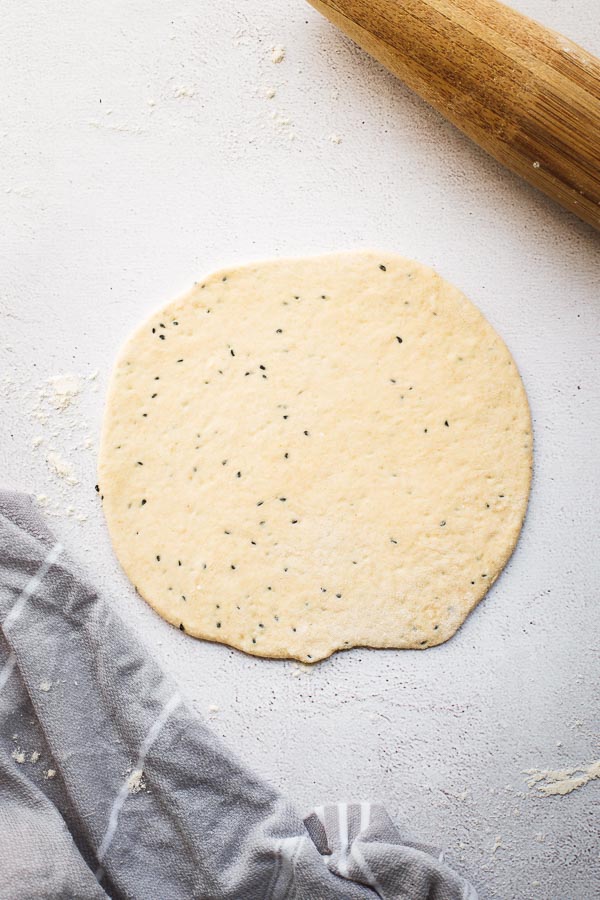
I typically make four small flatbreads of about 15 cm (6 inches). They fit perfectly in a 25 cm (10-inch) cast-iron skillet. You can also use the same amount of dough to make two large flatbreads. Just ensure they fit in your pan.
Divide the dough into four equal-sized pieces for small flatbread, or divide it in two for large flatbread. Shape each dough portion into a ball. And keep the dough balls covered under the damp kitchen towel.
On a lightly floured surface, use a rolling pin to roll the first ball into a thin flatbread – roughly ⅛ inch (3 mm). It doesn’t need to be perfectly round. You can sprinkle the top of the flatbread with flour if it sticks to the rolling pin.
Step 5: Cook in a hot dry pan
Once your pan is nice and hot, place a rolled flatbread in the pan. Cook the thin flatbread for 1–2 minutes until you see bubbles forming in the dough. Flip the dough with tongs or a spatula and cook for another 1–2 minutes.
Once flipped, it will puff up and create wonderfully charred brown spots on the bottom.
Remove the flatbread to a plate and repeat with the remaining dough balls, stacking the fluffy golden brown flatbreads as you go. Cover the stack with a kitchen towel.
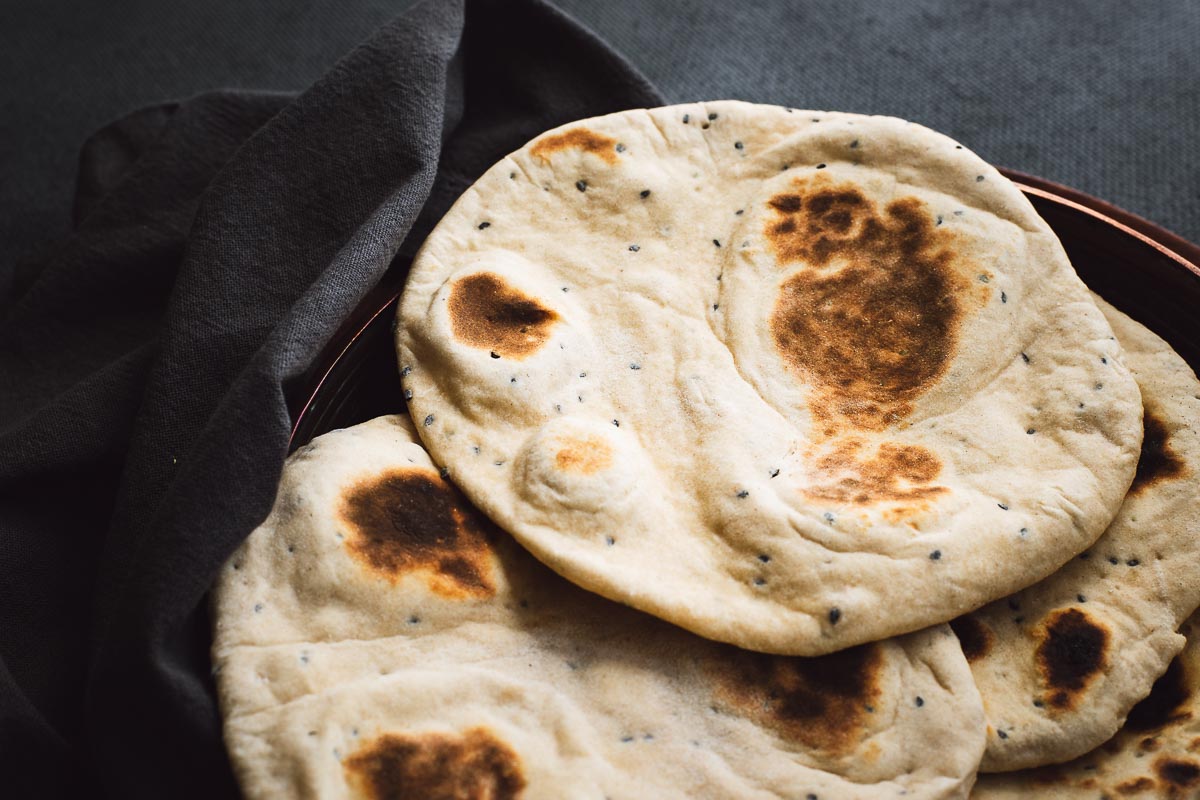
How to store yoghurt flatbread
Wrap leftover yoghurt flatbread in foil or plastic wrap or store it in an airtight container. It will keep well in the freezer for up to three months. Or store them at room temperature for one day.
Use stale flatbreads to make delicious pan-fried croutons. They’re also perfect for a Middle Eastern bread salad (fattoush).
Frequently asked questions
I use plain all-purpose or cake flour for fluffy and soft flatbreads. But you can also use spelt flour or any wheat flour, really. Or use a mix of whole wheat flour and plain flour.
Different flours have different water absorption properties. So, depending on the type of flour and the brand of Greek or natural yoghurt, you may need to adjust the ratio of wet to dry ingredients to get the perfect dough.
Yes! I specifically developed this easy no-yeast flatbread recipe with self-raising flour in mind.
It is not fussy. A little too much or too little of the raising agent won’t be your downfall here. If you use self-raising flour, just leave out the baking powder.
Serve flatbreads with dips (like harissa hummus), refreshing Arabic chopped salad and crispy falafel for a Middle Eastern mezze spread. Or top them with tomato paste, cheese and leftover veggies for a quick pizza flatbread.
Naan is a type of leavened flatbread from India. Other types of flatbread include pita (Middle Eastern), chapati (also Indian), tortilla (Mexican) and focaccia (Italian). While not the same, you can serve this easy flatbread instead of naan to scoop up your favourite curry.
Serving suggestions
Brush your yoghurt flatbread with melted butter, garlic butter or harissa butter. Then serve the buttered flatbread as a perfect side dish to stews, curries and soup.
Try the yoghurt flatbread with these soups & stews:
Yoghurt flatbread is also delicious with Middle Eastern breakfast dishes, like harissa shakshuka with feta, black lime & parsley or kuku sabzi (a Persian herb frittata packed with greens).
Cut the easy yoghurt flatbreads into triangles and serve with mezze and dips as you would fresh pita bread.
Try these Middle Eastern mezze and dips:
These no-yeast flatbreads are also great with curry. Serve it with butter chicken or aloo gobi as you would naan bread.
Or use a large flatbread as a pizza base. Spread the tender flatbreads with tomato paste (or rose harissa paste for a Middle Eastern touch). Scatter the flatbread pizzas with cheese and toppings like olives or cherry tomatoes and bake in a hot oven until the cheese is melted and bubbling.
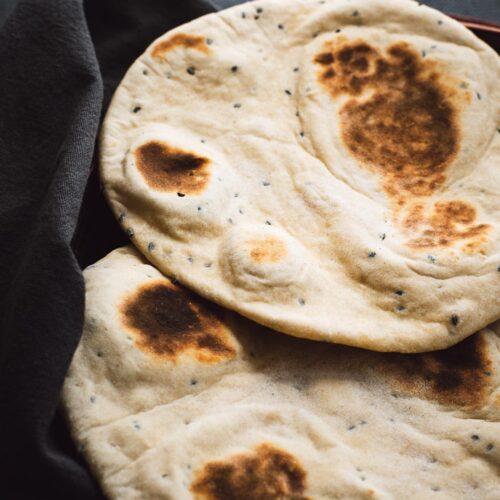
Equipment
- 10.25-inch cast iron skillet – Or any frying pan or skillet that fits your preferred size of flatbread.
Ingredients
- 1½ cups plain flour
- 1½ teaspoons baking powder
- ½ teaspoon fine salt
- 1 teaspoon nigella seeds (optional)
- ½ cup thick Greek yoghurt, or natural full-fat yoghurt
Instructions
Make the flatbread dough
- Reserve two tablespoons of flour and place the rest of the flour in a large bowl. Add the baking powder, salt and nigella seeds, and stir to distribute.
- Add the yoghurt. Roughly mix it with a fork and then get in with your hands to form a shaggy ball. If the dough is too sticky, add more flour – one tablespoon at a time.
- Tip the dough onto a lightly floured work surface and gently knead for a minute. The dough won’t be elastic like bread dough, but it should form a ball of slightly sticky dough. You can also do this in a food processor with a dough blade.
Rest the dough for 15 minutes
- Place the dough back in the mixing bowl and cover it with a damp kitchen towel. Leave to rest for 15 minutes.
- Heat a dry frying pan or skillet over medium-high heat. It should be large enough to fit one flatbread at a time.
Roll the dough into thin flatbread
- Divide the dough into 4 equal pieces for small flatbreads – or 2 for larger flatbreads – and shape each into a dough ball. Keep the dough balls covered under the damp kitchen towel.
- Dust your rolling pin lightly with flour and roll the first dough ball out until thin, roughly ⅛ inch (3 mm). It doesn’t need to be perfectly round.
Cook the flatbread
- Once the dry pan is nice and hot, cook one flatbread at a time for 1 – 2 minutes per side.
- Move the cooked flatbread to a plate and repeat with the remaining dough balls, stacking the flatbreads as you go.
Notes
- Depending on your yoghurt or flour, you may need to adjust the wet-to-dry ingredient ratio. If the dough sticks to your hands when kneading, add some of the extra flour. You want a smooth dough ball that does not stick to your hands or the work surface too much (slightly sticky is fine), but it should not be dry and crumbly.
- If you don’t mind the extra washing up, you can use a stand mixer with a dough hook or a food processor with a dough blade to mix the dough.
- Cover any leftover flatbreads in foil or plastic wrap and store them at room temperature for a day or freeze them in a freezer bag for up to 3 months.
- This recipe makes 4 small flatbread or 2 large ones. You can easily double the recipe and make whatever size of flatbreads you prefer – as long as your pan is larger than the flatbread.
